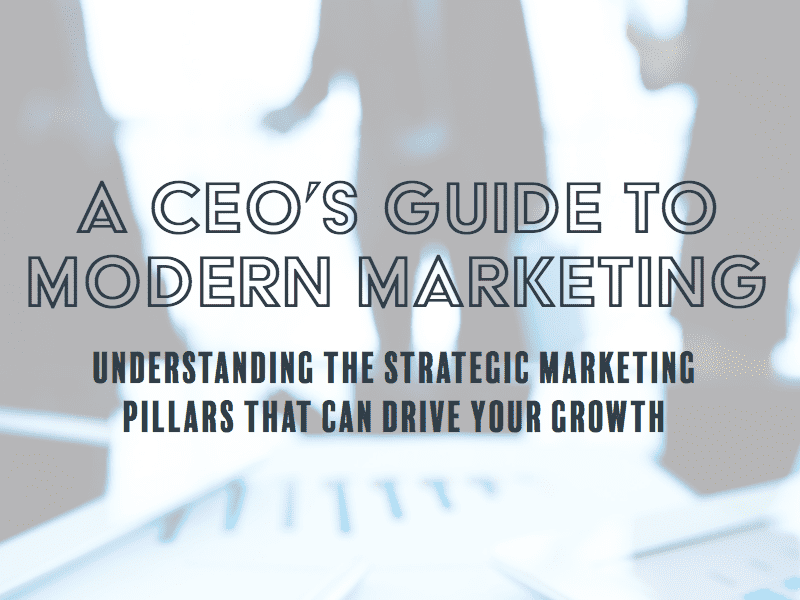Demystifying Profit Center Marketing: Guiding Principles for Leadership
Regardless of whether you’ve been paying attention, profit center marketing has cemented its place in the corporate world. According to the Singulars report, “Chief Growth Officer 2019: The State of the CGO,” around 14% of companies in the U.S. have a Chief Growth Officer (CGO). It also notes that 29% of companies have a Director or Head of Growth, and 41% have a Growth Marketing Manager.
Looking back, we could likely find the roots of profit center marketing in startup-centric “growth hacking” approaches, inbound marketing, or even simple human-centric marketing philosophies. A few years ago, a growth marketer in a B2B business only needed digital savvy, an experimental mindset, and some autonomy. (And they might have odd titles like “Chief Outreach Experimenter” or “Marketing Architect.”)
Looking forward, profit center marketing is still a moving target. Our modern definition of profit center marketing is broad-ranging and includes functions of a data analyst, marketing scientist, automation professional, and sales engineer.
And if you’re ready to pay attention, invest in marketing, and make better decisions about growth, we’ve put together a few principles for leadership. They can help you develop and expand to meet new challenges and opportunities in your organization.
1. For profit center marketing to take hold, a company needs to move from a fixed mindset to a growth mindset.
All too often, middle-market organizations get stuck in a “fixed mindset.” They believe their abilities are what they are today. They choose to be right—right now—over learning or developing.
A “growth mindset” is where you believe skill is derived from ongoing effort and experimentation. It’s about creating a culture of learning and improvement at all levels of your organization.
In a past life, I used to draw three concentric circles to help explain the concept. The center circle was the Comfort Zone. The middle circle, the Groan Zone. The outermost circle, the Growth Zone. The idea was you had to push out of your Comfort Zone into the uncomfortable Groan Zone. Eventually, it would no longer be uncomfortable, and you’d find your Comfort Zone had expanded—in other words, you’d have grown.
Middle-market businesses stuck in a fixed mindset exhibit two qualities that hinder their ability to grow: comfort with the status quo and a reluctance toward risk. They know what they know, and they mine their vein, niche, referral network. But they do so at the expense of establishing a growth position, and they increase their risk of dependency on a finite set of customers needing exactly what they offer right now.
For a profit center marketing strategy to be effective, your business must be able embrace a growth mindset. You must be ready and willing to expand into new markets and leverage new marketing tools and techniques. You must be willing to research, build, measure, and fail forward.
2. Remove communication silos between departments.
Today, the role of a Chief Growth Officer (CGO) spans across sales, marketing, and product. The role helps everyone serve two goals: drive long-term retention and top-line growth.
Here are a few common benefits of having an executive presence that works actively across departments:
- Improves collaboration. Organizations have a lot of moving parts and often silo their efforts. It’s common that departments in middle-marketing businesses are trying to achieve similar goals but not communicating with each other. Having an active cross-departmental CGO forces collaboration and empowers achievement by breaking down silos and focusing mutual effort.
- Creates a profit-focused culture. When cross-departmental teams are clear on their shared goals, they better understand each other’s efforts, motivations, and failures. This creates an environment that allows employees to learn and develop together. They become more authentic and value-driven, which results in higher levels of motivation and performance.
- Reveal more significant insights into the customer lifecycle. Organizations with little cross-pollination can create blind spots in customer acquisition and the customer experience. For example, do sales and marketing have a shared definition of a qualified lead? Bridging the gap between the two functions and creating a revenue team can drive more informed strategies and better results.
Profit center marketing plays a vital and essential part in our understanding of the entire customer lifecycle. Marketers — working together with sales, customer support, and data teams — can challenge perceptions and investigate what the future customer may need and how it gets done.
3. Extend your ROI timeline.
Executives make essential decisions about high-level budget, strategy, and personnel, but they aren’t always experts on long-term or scalable growth. It’s quite common for middle-market companies to develop a myopic focus on short-term revenue boosts or wins, while leaving new markets or long-term business models on the table. That can put pressure on every tactic driving immediate results—which limits experimentation and stifles longer-term thinking.
Investing in thoughtful marketing strategies and their execution helps companies hedge against their near-sighted tendencies. If they can spread their investments (and their expected ROI) across a longer timeline, it opens the door to efforts that might not pay off today, but years down the road.
4. Invest in people and processes.
Opinions abound when it comes to building out a profit center marketing team. A common recipe for failure is hiring young marketing managers and telling them to focus on growth. Another is hiring outsourced agencies to help tactical efforts.
These recipes lead to employee churn and disjointed marketing collateral due to their lack of a core ingredient of success: context.
Incorporating a Fractional Chief Growth Officer in a leadership role is a great option to create context and empower marketing talent. Fractional CGOs can set the strategy, identify needed in-house and outsource resources, and define roles and responsibilities that allow younger or more tactical talent to succeed.
5. Define and watch the right profit center marketing metrics.
It’s easy to get carried away with the idea of fast growth, but if you don’t focus on a small handful of metrics, you can lose sight of what matters in achieving the goal.
When there’s no bigger picture to the reporting, marketers can report on so many metrics that they develop a sort of micro-measurement blindness. For a profit center marketing effort to gain and maintain traction, you need to identify metrics that are reflective of the marketing program’s maturity and reflect how you want the program to evolve. That typically means a balance between activity-based metrics (e.g., social posts per week) and long-term health metrics (e.g., marketing generated revenue). Over time, the reporting is likely to evolve, and you might include everything from MoM retainer revenue, grow by service offering, grow from commissions, net promoter score, and more.
But the metrics need to be tailored by organization, market, business model and industry. There is no one-size-fits-all approach.

Profit center marketing is on the rise!
If you’re in a leadership role in a middle-market organization, you know all too well the complexity of focusing and then scaling your marketing efforts. If you’ve put together a team, a creative agency, and analytics, but not seeing measurable impact, you may want to consider bringing in an outside perspective. If you can find a marketing lens. It’s a cost-effective, collaborative, and proven way to maximize sales and retain customers while driving down costs.
To learn more about structuring a marketing department, you can download our guide below.






